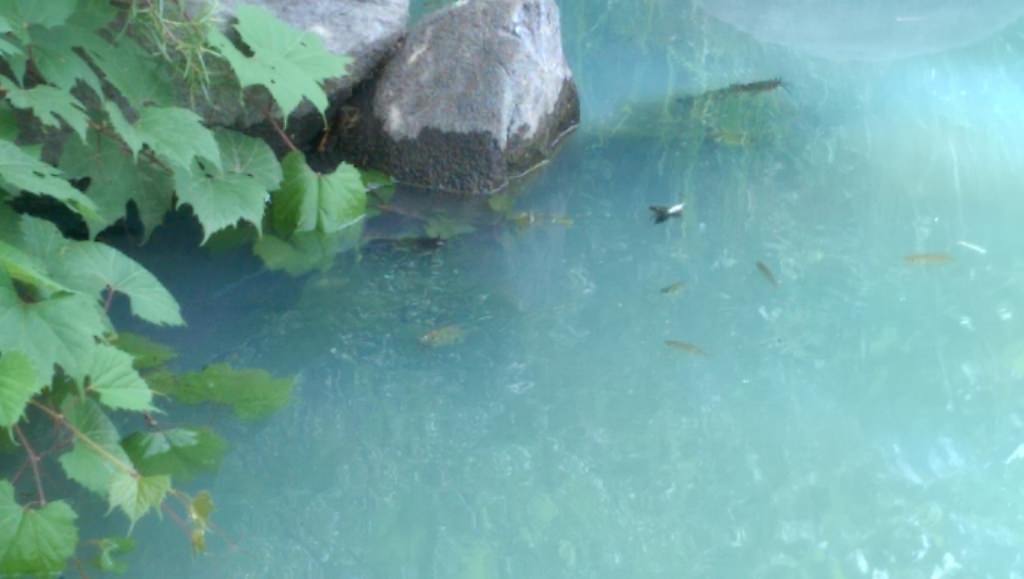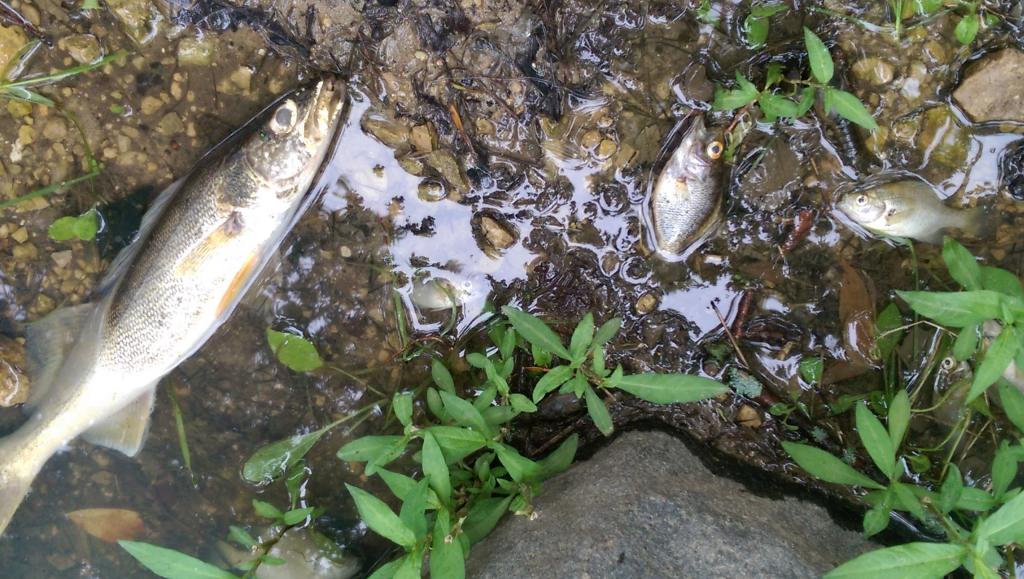First, but not last, algae bloom spells danger for Madison swimmers, fish

Fish at the surface of Lake Mendota, gulping air and trying to escape a massive algae bloom. Photo: Tyler Tunney
It was a hot, sunny day and Steve Carpenter couldn’t believe the view from his second-floor office on the shoreline of Lake Mendota. As far as he could see from the Hasler Laboratory for Limnology — looking west to the University of Wisconsin–Madison rowing team’s boathouse and east to the Edgewater Hotel and James Madison Park — the calm, still water looked just like teal-blue paint.
It was a massive bloom of toxic blue-green algae and “it is the worst one I’ve seen in a long time,” says Carpenter, director of UW–Madison’s Center for Limnology. “It’s been many, many years since I’ve seen one this bad.”
In fact, the bloom that hit Madison on Friday, June 16th, was one of the largest blooms to mar Mendota’s shoreline since the summers of 1993 and 1994, he says.

Walleye, panfish and crayfish were just some of the organisms killed in the bloom. Photo: Tyler Tunney
Like this summer, those summers were also marked by classic conditions for an algae bloom. Higher-than-average rainfall has swept phosphorus from upstream dairy and crop operations into Lake Mendota, where it is just as good at growing algae as it is soybeans.
Then the weather got warm.
“So we had perfect conditions for blue-greens because they like it warmer than other algae and they grow fast in warm water,” Carpenter says. As soon as it got hot, “we had this incredible spin up of cyanobacteria (blue-green algae) in the lake surface water and then the wind stopped, and these kinds of algae are buoyant and they just floated to the top in this awful scum.”
Driven by currents and winds, that scum eventually made its way to Tenney Park, where the Yahara River carries water from Lake Mendota into Lake Monona. By Saturday, Tyler Tunney, a postdoctoral researcher at the Center for Limnology, stood on a bridge spanning the narrow waterway and looked down in disbelief.
“There were dead fish on the surface of the river and others visibly struggling, swimming in erratic circles and literally jumping out of the water,” he recalls. “And it was species like bluegill and other panfish you don’t normally see behaving that way.”
When Tunney went down to investigate, he found bodies of fish — from walleye and bluegill to pike and carp — beginning to pile up along the riverbank while crayfish crawled out of the water and died.
Most algae-induced fish kills occur because of a lack of oxygen. When huge amounts of algae die and begin to decompose, the microbes doing the decomposing use up a lot of oxygen and produce a lot of carbon dioxide. Eventually, fish can’t pull enough oxygen out of the water and try to head to safer waters.
Toxins produced by the algae are also a concern to fish — and people.
According to the Wisconsin Department of Natural Resources, in addition to wildlife impacts, blue-green algae blooms can cause a host of human and pet health problems through skin contact, swallowing water or, in some cases, when inhaled by boaters or water skiers speeding through a bloom.
Different species of algae can produce different types of toxins with different risks. Some cause inconveniences like skin rashes or diarrhea, others can lead to liver damage, seizures or paralysis.
Peter Lisi, another Center for Limnology postdoc, has been monitoring temperatures in the Yahara River, and over the following weekend his probes recorded temperatures in the river near 80 degrees, the highest they’ve been this year. While those temperatures alone won’t cause a fish kill, they aided the heat-loving algae as it made its way downstream.
“Lake outlets, like the Yahara River, are a reflection of what is happening upstream in a lake,” Lisi says. “What happened in Mendota is we had a big bloom and it blew out the outlet and conditions got too harsh for fish.”
The primary driver behind algae blooms in Madison’s lakes is agricultural runoff.
“Despite all of the work we’ve done, we’ve still got a tremendous amount of manure on the land and phosphorus in the soil and when we get these unusually high precipitation events, that material can just wash into the lake,” says Carpenter.
Climate change is linked by scientists to more frequent and stronger storms that increase the nutrients leaching into area waterways, as well as warmer temperatures that promote blue-green algae growth. Friday’s recorded high of 86 was nearly ten degrees over the historical average. Invasive species like the zebra mussel, which is known to promote blue-green algae growth, also contribute to algae blooms, which Carpenter says will continue.
“This is likely not a one-off,” says Carpenter, “particularly if it gets hot again. That was probably just the summer’s first heat wave.”







